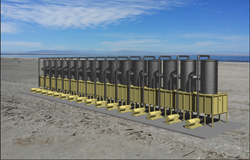 We're working to demonstrate a Multi-Effect Distillation (MED) process using Vertical Tube Evaporators (VTE) to dramatically improve the thermal efficiency of MED technology using geothermal steam as a renewable heat source. The process will also recover potable water and commercial salt from the Salton Sea in Imperial Valley, California. Geothermal steam provides the thermal energy source for the distillation process. This renewable energy resource is provided by BHE Renewables for the testing. This Project is funded by the U.S. Bureau of Reclamation and Sephton Water Technology, Inc.
We're working to demonstrate a Multi-Effect Distillation (MED) process using Vertical Tube Evaporators (VTE) to dramatically improve the thermal efficiency of MED technology using geothermal steam as a renewable heat source. The process will also recover potable water and commercial salt from the Salton Sea in Imperial Valley, California. Geothermal steam provides the thermal energy source for the distillation process. This renewable energy resource is provided by BHE Renewables for the testing. This Project is funded by the U.S. Bureau of Reclamation and Sephton Water Technology, Inc.
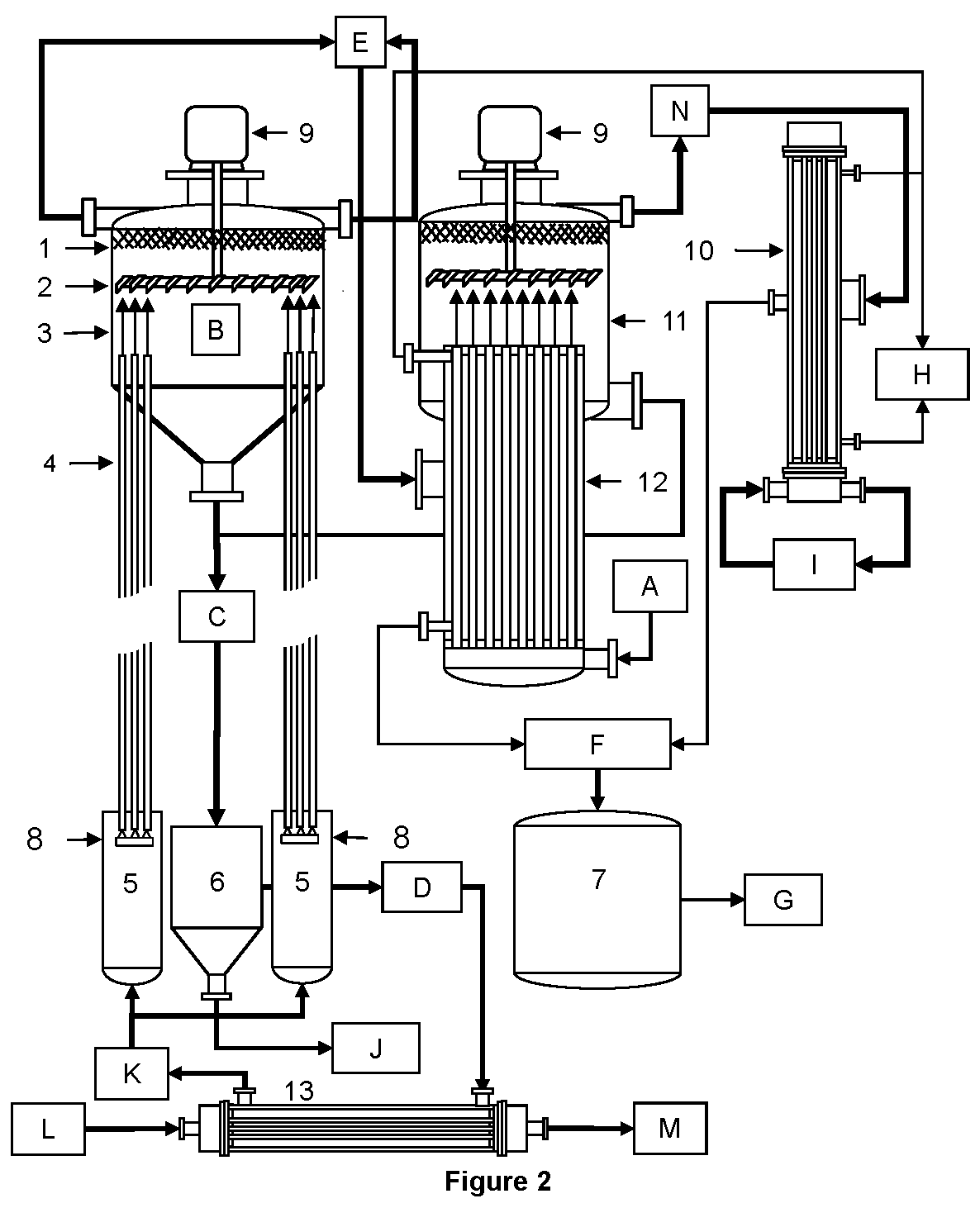 The Barometric Evaporator / Crystallizer is a novel thermal desalination technology that can use moderate temperature waste heat, solar, or geothermal heat to directly desalinate brackish water or seawater. The patent pending Barometric Evaporation / Crystallization Process makes direct use of thermal energy in a warm or hot water source to drive evaporation into a vacuum through vertical continuous flash channels. A Barometric Evaporator can be constructed with minimal motive parts, typically one vacuum pump, a fan for air-cooling and/or a circulation pump for water or geo-cooling. Other flows are driven by air pressure, vapor pressure, and gravity. This makes for an easy to operate, easy to maintain system with very low electrical power requirements. This technology would be useful in small communities with underdeveloped infrastructure. An expanded pilot phase of this project is underway. This Project is funded by the U.S. Bureau of Reclamation and Sephton Water Technology, Inc.
The Barometric Evaporator / Crystallizer is a novel thermal desalination technology that can use moderate temperature waste heat, solar, or geothermal heat to directly desalinate brackish water or seawater. The patent pending Barometric Evaporation / Crystallization Process makes direct use of thermal energy in a warm or hot water source to drive evaporation into a vacuum through vertical continuous flash channels. A Barometric Evaporator can be constructed with minimal motive parts, typically one vacuum pump, a fan for air-cooling and/or a circulation pump for water or geo-cooling. Other flows are driven by air pressure, vapor pressure, and gravity. This makes for an easy to operate, easy to maintain system with very low electrical power requirements. This technology would be useful in small communities with underdeveloped infrastructure. An expanded pilot phase of this project is underway. This Project is funded by the U.S. Bureau of Reclamation and Sephton Water Technology, Inc.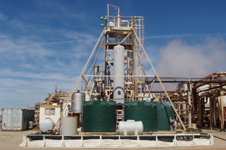 We demonstrated a Vertical Tube Evaporation (VTE) process to recover potable water and useful salts from the Salton Sea in Imperial Valley, California. Geothermal steam provided the thermal energy source for the salt separation and distillation process. The VTE process can operate with geothermal steam at atmospheric pressure or less, not practical for electric power generation. This renewable energy resource was provided by CalEnergy Operating Company to the tests. A VTE Pilot Plant has been operational since 2006 and a larger VTE Demonstration Plant was assembled next to the geothermal plant. This Project was funded by the U.S. Bureau of Reclamation and the California Department of Water Resources.
We demonstrated a Vertical Tube Evaporation (VTE) process to recover potable water and useful salts from the Salton Sea in Imperial Valley, California. Geothermal steam provided the thermal energy source for the salt separation and distillation process. The VTE process can operate with geothermal steam at atmospheric pressure or less, not practical for electric power generation. This renewable energy resource was provided by CalEnergy Operating Company to the tests. A VTE Pilot Plant has been operational since 2006 and a larger VTE Demonstration Plant was assembled next to the geothermal plant. This Project was funded by the U.S. Bureau of Reclamation and the California Department of Water Resources.
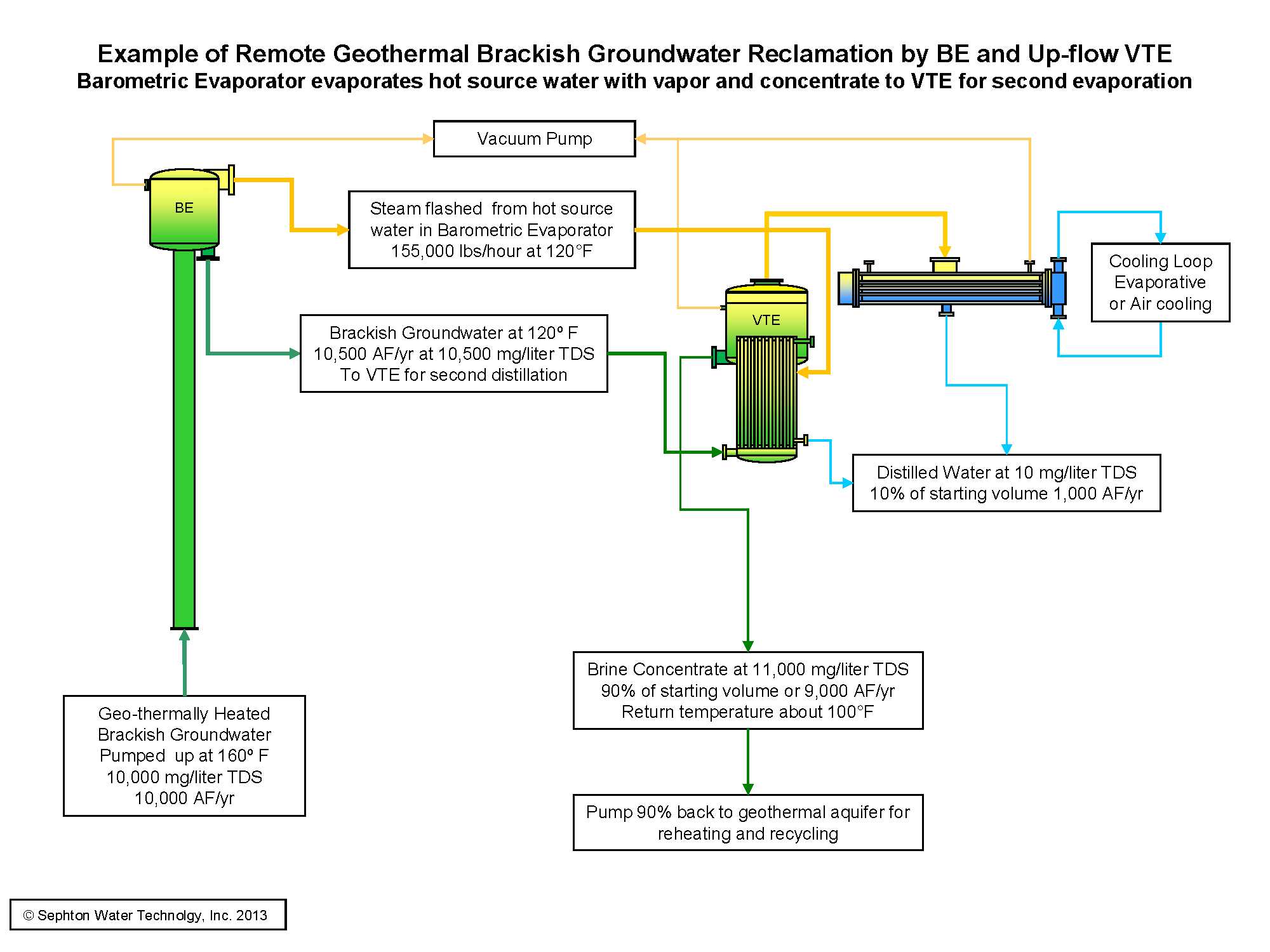 The Barometric Evaporator makes direct use of thermal energy in a warm or hot water source to drive evaporation into a vacuum through vertical continuous flash channels. A Barometric Evaporator can be constructed with minimal motive parts, typically one vacuum pump, a fan for air-cooling and/or a circulation pump for water or geo-cooling. This project completed prototype testing proving the fundamental operating principles and demonstrating energy efficient evaporation. This Project was funded by the U.S. Bureau of Reclamation and Sephton Water Technology, Inc.
The Barometric Evaporator makes direct use of thermal energy in a warm or hot water source to drive evaporation into a vacuum through vertical continuous flash channels. A Barometric Evaporator can be constructed with minimal motive parts, typically one vacuum pump, a fan for air-cooling and/or a circulation pump for water or geo-cooling. This project completed prototype testing proving the fundamental operating principles and demonstrating energy efficient evaporation. This Project was funded by the U.S. Bureau of Reclamation and Sephton Water Technology, Inc. This project was a collaboration with the Imperial Irrigation District designed to test the use of a Salinity Gradient Solar Pond to employ concentrated salts from the Salton Sea to capture and store thermal energy from the desert sun and use it to distill Salton Sea water to replace evaporation losses in the solar pond and in an adjacent marine habitat pond. This project addressed two critical environmental problems expected to impact the south shore of the Salton Sea in the next decade. The Salton Sea is receding and becoming hyper-saline due to reduced inflows and a high evaporation rate. The Sea has no outlet other than evaporation, so salts and contaminants concentrate. The receding shoreline will expose tens of thousands of acres of lakebed consisting of dust laced with a mix of salts and chemicals. High winds will blow this onto surrounding farms and communities. The concentration of salts and other contaminants in the shrinking lake is now killing the fish living in it and depriving migratory birds of a critical stopover and food source on the Pacific Flyway.
This project was a collaboration with the Imperial Irrigation District designed to test the use of a Salinity Gradient Solar Pond to employ concentrated salts from the Salton Sea to capture and store thermal energy from the desert sun and use it to distill Salton Sea water to replace evaporation losses in the solar pond and in an adjacent marine habitat pond. This project addressed two critical environmental problems expected to impact the south shore of the Salton Sea in the next decade. The Salton Sea is receding and becoming hyper-saline due to reduced inflows and a high evaporation rate. The Sea has no outlet other than evaporation, so salts and contaminants concentrate. The receding shoreline will expose tens of thousands of acres of lakebed consisting of dust laced with a mix of salts and chemicals. High winds will blow this onto surrounding farms and communities. The concentration of salts and other contaminants in the shrinking lake is now killing the fish living in it and depriving migratory birds of a critical stopover and food source on the Pacific Flyway. 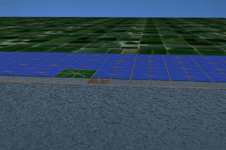 A large scale implementation could cover many acres of critical dust emitting lakebed with salinity gradient solar ponds in a progressive buildout as the shoreline recedes. The ponds would eliminate wind-blown salt dust from the covered areas. The ponds use concentrated salt solution to capture and store solar energy as heat. Solar energy collected by the ponds can be used to supply heat for distillation or converted from heat to electricity and sold providing solar energy to the grid on demand at any time of day or night. The salinity gradient solar ponds are substantially more efficient when the thermal energy is used directly for thermal desalination rather than converting all of it to electricity. Thermal desalination driven by heat from the ponds can also maintain the salinity gradient that traps solar heat in the bottom of the pond.
A large scale implementation could cover many acres of critical dust emitting lakebed with salinity gradient solar ponds in a progressive buildout as the shoreline recedes. The ponds would eliminate wind-blown salt dust from the covered areas. The ponds use concentrated salt solution to capture and store solar energy as heat. Solar energy collected by the ponds can be used to supply heat for distillation or converted from heat to electricity and sold providing solar energy to the grid on demand at any time of day or night. The salinity gradient solar ponds are substantially more efficient when the thermal energy is used directly for thermal desalination rather than converting all of it to electricity. Thermal desalination driven by heat from the ponds can also maintain the salinity gradient that traps solar heat in the bottom of the pond. 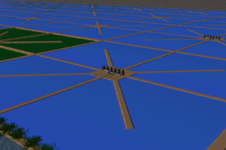 Creation of the ponds using brine concentrated from the Salton Sea would act as a salt sink for the Sea. Desalinated Salton Sea water could be returned to the Sea directly, but it can provide a more immediate benefit by supplying clean water to habitat ponds critically needed to sustain the local aquatic ecosystem. Before undertaking any large scale construction of salinity gradient solar ponds at the Salton Sea, there are are few technical innovations that would help the concept be more cost effective and better suited to solve local problems. Pilot testing of innovations to enhance the thermal efficiency of the ponds, reduce the cost of key construction materials, and reduce the loss of water to surface evaporation has been undertaken. Use of thermal energy from a salinity gradient solar pond to drive a novel Barometric Evaporator and a VTE were planned in the pilot test.
Creation of the ponds using brine concentrated from the Salton Sea would act as a salt sink for the Sea. Desalinated Salton Sea water could be returned to the Sea directly, but it can provide a more immediate benefit by supplying clean water to habitat ponds critically needed to sustain the local aquatic ecosystem. Before undertaking any large scale construction of salinity gradient solar ponds at the Salton Sea, there are are few technical innovations that would help the concept be more cost effective and better suited to solve local problems. Pilot testing of innovations to enhance the thermal efficiency of the ponds, reduce the cost of key construction materials, and reduce the loss of water to surface evaporation has been undertaken. Use of thermal energy from a salinity gradient solar pond to drive a novel Barometric Evaporator and a VTE were planned in the pilot test. 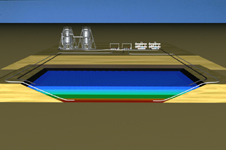 Pilot scale studies using Salinity Gradient Solar Ponds to drive thermal desalination have been carried out in other regions. However, this technology must be adapted to local climate, soil, and water conditions. A paper feasibility study with lab scale tests of water, soils, and climate conditions in the Salton Sea location was conducted by NASA-JPL in the 1980's with a positive recommendation, but no pilot or demonstration was built. This project would advance previous work by pilot testing methods to reduce evaporative and heat losses from a solar pond and test compatibility with the local biology and hydrology. At a minimum, a 1/4 acre salinity gradient solar pond and a 1/4 acre marine habitat pond could be constructed on newly exposed Salton Sea lakebed. The site and available distillation equipment would support ponds up to 5 acres. The VTE Demonstration Plant would supply concentrated Salton Sea brine to the salinity gradient solar pond and distilled water to the marine habitat pond. The VTE Pilot or Demonstration Plant would be relocated to the solar pond to maintain the salinity gradient and supply distilled water sourced from the Salton Sea to sustain both the habitat and solar pond against evaporative losses.
Pilot scale studies using Salinity Gradient Solar Ponds to drive thermal desalination have been carried out in other regions. However, this technology must be adapted to local climate, soil, and water conditions. A paper feasibility study with lab scale tests of water, soils, and climate conditions in the Salton Sea location was conducted by NASA-JPL in the 1980's with a positive recommendation, but no pilot or demonstration was built. This project would advance previous work by pilot testing methods to reduce evaporative and heat losses from a solar pond and test compatibility with the local biology and hydrology. At a minimum, a 1/4 acre salinity gradient solar pond and a 1/4 acre marine habitat pond could be constructed on newly exposed Salton Sea lakebed. The site and available distillation equipment would support ponds up to 5 acres. The VTE Demonstration Plant would supply concentrated Salton Sea brine to the salinity gradient solar pond and distilled water to the marine habitat pond. The VTE Pilot or Demonstration Plant would be relocated to the solar pond to maintain the salinity gradient and supply distilled water sourced from the Salton Sea to sustain both the habitat and solar pond against evaporative losses.  This project was partly funded under a California State Department of Water Resources grant awarded to the Imperial Irrigation District and Sephton Water Technology in 2013 and by a grant from the U.S. Bureau of Reclamation awarded in 2014. The Imperial Irrigation District cancelled the Federal grant in January 2018. After imposing over two years of delays in what was intended to be a three year project, the Imperial Irrigation District Water Department staff terminated this project on March 15th 2018, retroactive to Jan 1st, in favor of low cost waterless dust mitigation methods suitable for a dessicated Salton Sea. The methods preferred by the Imperial Irrigation District have been borrowed from Owens Dry Lake and are being implemented by the same contractors that worked on that $3 billion project.
This project was partly funded under a California State Department of Water Resources grant awarded to the Imperial Irrigation District and Sephton Water Technology in 2013 and by a grant from the U.S. Bureau of Reclamation awarded in 2014. The Imperial Irrigation District cancelled the Federal grant in January 2018. After imposing over two years of delays in what was intended to be a three year project, the Imperial Irrigation District Water Department staff terminated this project on March 15th 2018, retroactive to Jan 1st, in favor of low cost waterless dust mitigation methods suitable for a dessicated Salton Sea. The methods preferred by the Imperial Irrigation District have been borrowed from Owens Dry Lake and are being implemented by the same contractors that worked on that $3 billion project. 
